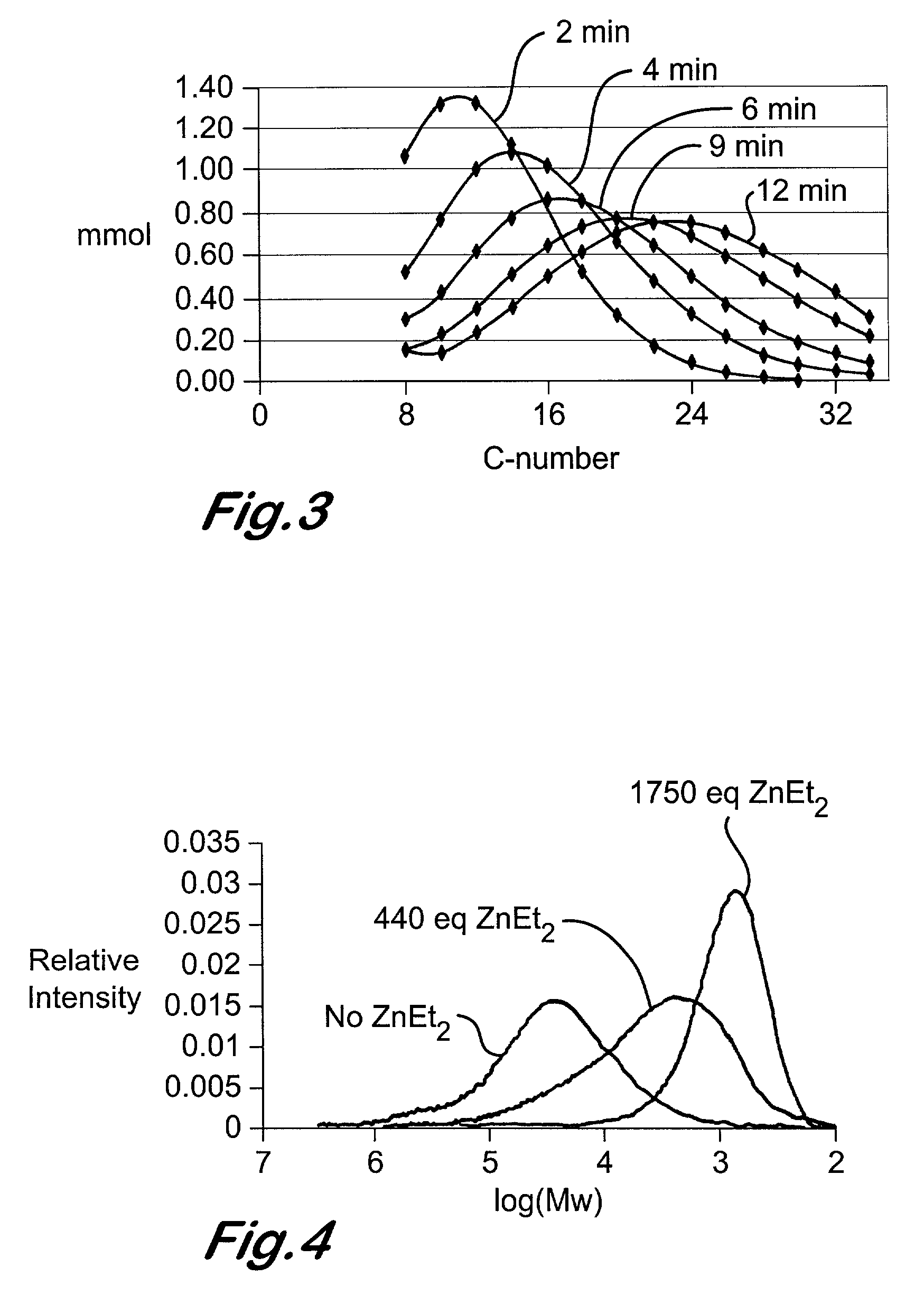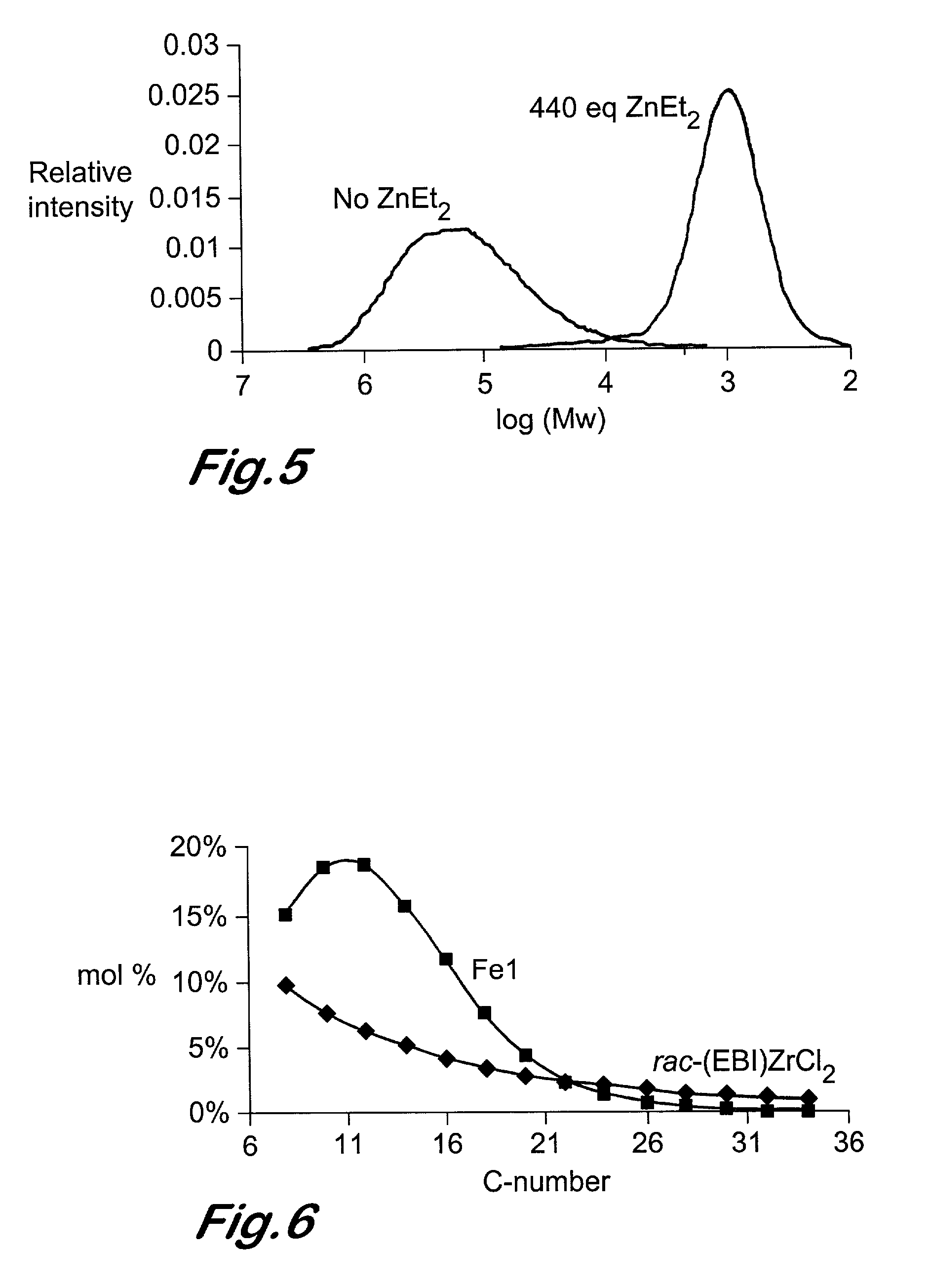Chain growth reaction process
a chain growth and reaction technology, applied in the field of chain growth reaction preparation of zinc alkyls, can solve the problems of limiting the usefulness of the known catalysed chain growth process and increasing the cost of the reaction
- Summary
- Abstract
- Description
- Claims
- Application Information
AI Technical Summary
Problems solved by technology
Method used
Image
Examples
examples
[0071]Manipulation of complexes, zinc alkyls, and optional activators, as well as the assembly and disassembly of reactors were conducted under a nitrogen atmosphere. Ethylene was polymer grade, used without purification. 2,6-bis[1-(2,6-diisopropylphenyl)imino)ethyl]pyridine iron(II) chloride and 2,6-bis[1-(2,6-diisopropylphenyl)imino)ethyl]pyridine cobalt(II) chloride were prepared according to the established procedure described in WO 99 / 12981. 2,4-bis[(2,6-diisopropylphenylimino)benzyl]-6-methylpyrimidine iron (II) chloride was prepared according to the procedure disclosed in GB 0100249. The complex used in Example 14 was prepared according to the procedure in WO 00 / 50470. The complex used in Example 15 was prepared according to the procedure of GB 0112023.
[0072]Bis(n-butylcyclopentadienyl)zirconium dichloride and [1,4-bis(2,6-diisopropylphenyl)-1,4-diaza-2,3-dimethylbutadiene] nickel(II) bromide were prepared according to the established literature procedures. MAO (10 wt % in to...
example a
Synthesis of Dihexylzinc
[0073]n-Hexylmagnesiumchloride was prepared by addition of a solution of 1-chlorohexane (13 g, 108 mmol, filtered through neutral active alumina) in 50 ml diethylether to 3.2 g Mg in 40 ml diethylether over a period of 30 min. The mixture was allowed to reflux for an additional 2 h. The solution was transferred to 53 ml of a 1.0 M solution of ZnCl2 (53 mmol) in diethylether over a period of 30 min and the reaction mixture was stirred overnight. The mixture was filtered and the remaining salts were washed twice with 100 ml diethylether. The combined filtrates were concentrated by removal of the solvent in vacuo. Vacuum distillation (0.08 mbar, 68° C.) gave dihexylzinc as a colourless liquid in a 63% yield (7.83 g, 33.2 mmol). 1H NMR (250 MHz, C6D6, 298 K): δ 1.57 (br quintet, 2H, Zn—CH2—CH2—, 3J=7 Hz), 1.36–1.28 (m, 6H, —CH2—CH2—CH2—CH3), 0.93 (br t, 3H, —CH3, 3J=7 Hz), 0.29 (t, 2H, Zn—CH2—, 3J=7 Hz) 13C NMR (62.9 MHz, C6D6, 298 K): δ 36.6, 32.3, 26.7, 23.1, 1...
example 1
Catalysed Chain Growth Using an Iron Pyridylbisimine Catalyst
A) Preparation of Catalyst Solution
[0074]In a Schlenk flask was placed 2,6-bis[1-((2,6-diisopropylphenyl)imino)ethyl] pyridine iron(II) chloride (31 mg; 0.050 mmol) and 24 ml toluene. To the colourless solution was added MAO (3.0 ml), giving a clear orange solution that was stirred for 5 minutes at room temperature.
B) Chain Growth Reaction
[0075]In a 500 ml Schlenk flask was placed toluene (50 ml) and diethylzinc (2.5 ml of a 0.87M solution in hexane). The Schlenk flask with suba seal was evacuated and back-filled with ethylene (0.75 bar overpressure). Into this mixture was injected 2.5 ml of the catalyst solution prepared under A (containing 5.0 μmol Fe) giving a pale yellow solution. The reaction was run at room temperature for 30 minutes, whereby an exothermic reaction occurred within 1 minute. After 15 minutes the reaction mixture became viscous and cloudy and the temperature dropped. The reaction was stopped after 30 m...
PUM
| Property | Measurement | Unit |
|---|---|---|
| pressures | aaaaa | aaaaa |
| temperatures | aaaaa | aaaaa |
| temperatures | aaaaa | aaaaa |
Abstract
Description
Claims
Application Information
 Login to View More
Login to View More - R&D
- Intellectual Property
- Life Sciences
- Materials
- Tech Scout
- Unparalleled Data Quality
- Higher Quality Content
- 60% Fewer Hallucinations
Browse by: Latest US Patents, China's latest patents, Technical Efficacy Thesaurus, Application Domain, Technology Topic, Popular Technical Reports.
© 2025 PatSnap. All rights reserved.Legal|Privacy policy|Modern Slavery Act Transparency Statement|Sitemap|About US| Contact US: help@patsnap.com



